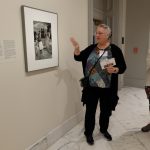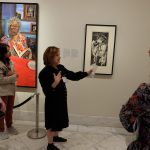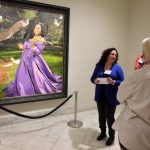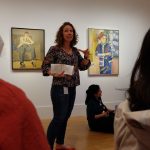By Professor Tiffany Banks On Tuesday, September 30th , students from my COMM 108: Foundations…
As soon as the Smithsonian Faculty Fellowship cohort arrived at the Donald W. Reynolds Center for American Art and Portraiture, they were escorted by Briana Zavadil White to one of the National Portrait Gallery’s classrooms. There, the fellows discovered five content-rich pamphlet-posters any educator could choose to adorn an office door or wall, but they practically beg to be used in a classroom activity. On their own, Michelle Obama, Barack Obama, Flora, John Lewis, and The Return to Aztlán can inspire deep conversation and reflection; however, educators at the NPG know reading portraiture is its own language. The poster-pamphlet dedicated to Michelle Obama’s portrait, for example, opens to reveal “About the Artist” and “About the Subject” pages; then, when further unfolded, four additional sections share questions to ask about the portrait, extensions into other relevant topics, information about the Outwin Boochever Portrait Competition, and an “About the Painting” overview. Finally, when fully unfolded, a 20×24 poster is ready for room decoration.
While the posters alone serve as excellent teaching tools, Zavadil White, the Head of Education and Public Programs at the National Portrait Gallery, was prepared with so much more for us to marvel over. From the museum’s history and mission to robust activities in studying portraiture, Zavadil White cultivated content to wow her audience and even put the fellows to work.
Founded by Congress in 1962, the NPG opened only six years later to tell the story of the United States through its pioneers, innovators, and inspirators—folks responsible for significant contributions. Over the years, the museum has accumulated approximately 26,000 portraits, but—fun fact—it typically shows only 900 objects at a time! Its vast collection has helped to make the NPG especially relevant and accessible to visitors, but Zavadil White is quick to acknowledge the challenges of portraiture, particularly its elitist origins. Just consider the respective social standing of the sitter, artist, and commissioner tied to any portrait in NPG’s permanent exhibit Out of Many: Portraits from 1600 to 1900. In spite of this truth, Zavadil White helped us to recognize portraits as mirrors and windows. They not only invite the viewer to make meaning and self-reflect but also to investigate history and recognize who is and who is not represented.
Of course, the fellows were fascinated by the ensuing conversation, and they peppered Zavadil White with question after question for quite some time before she assigned their first mission: Apply the 10 Elements of Portrayal to the NPG’s Recent Acquisitions. If unfamiliar with the 10 elements, too, fear not! The NPG and this Smithsonian Learning Lab have you covered!
Before we knew it, we were walking briskly through Out of Many, rounding a corner, and discovering the all-encompassing beauty of the NPG’s recently acquired pieces. Then, Zavadil White handed out ten laminated cards and set the fellows free, charging them with their objective: Identify a portrait representative of an element of portrayal, and be sure to defend your choice! Admittedly, I was sad to participate from the sidelines, but it was a joy to watch the competition take shape, and the cohort did not disappoint with their selections. Check them out:
ten laminated cards and set the fellows free, charging them with their objective: Identify a portrait representative of an element of portrayal, and be sure to defend your choice! Admittedly, I was sad to participate from the sidelines, but it was a joy to watch the competition take shape, and the cohort did not disappoint with their selections. Check them out:
- Melissa McCeney selected Oprah Winfrey by Shawn Michael Warren for pose.
- Ted Shusterman chose Bisa Butler’s Octavia Butler for color.
- For setting, Ellen Olmstead chose Mildred Howard’s That Was Then and This Is Now III.
- Sadegh Foghani found Michele Mattei’s Betye Saar best represented hairstyle.
- Gadis Effendi appreciated artistic style in Sedrick Huckaby’s Opal Lee.
- Miriam H. Beerman’s self-portrait, Miriam Beerman, according to Serena Gould, featured a powerful facial expression.
- Rebin Muhammad admired Tyler Mitchell’s See Your Halo, which captured Beyoncé in extravagant clothing.
- Teresa Lew pointed to the meaningful object displayed in Joan Roth’s portrait Rabbi Sally Priesand.
- Evan Crump drew attention to one of the most unique pieces: Self-Portrait by Shigeko Kubota. This was the only video on display in the Recent Acquisitions exhibit, so the medium distinguished it from the surrounding artworks.
- Finally, Kay Ahmad spoke to how scale was an important element of Melinda Blauvelt’s portrait of Nellie Mae Rowe in Nellie Mae Rowe, Vinings, Georgia.
As I listened to the fellows justify their choices, I found myself imagining the possibilities for our students. What a clever, energized way to drive student engagement and invite inquiry. The enthusiasm was palpable as the fellows explored the portraits on display; how fun would it be to share this opportunity with our own students, too?
 Professor Serena Gould unpacks my question further in her reflection: “Portraits are fascinating representations of identity as seen from self-reflection and as observers, often juxtaposing both simultaneously. The many questions Briana brought to our consideration illustrated the techniques and possibilities of making meaning. This became a visual parallel to my training in reading literature: multiple layers come together in an evolving and ever-changing series of perspectives and angles. This is certainly a place and a project for my students, providing a perfect opportunity to relate to their own selfhood.”
Professor Serena Gould unpacks my question further in her reflection: “Portraits are fascinating representations of identity as seen from self-reflection and as observers, often juxtaposing both simultaneously. The many questions Briana brought to our consideration illustrated the techniques and possibilities of making meaning. This became a visual parallel to my training in reading literature: multiple layers come together in an evolving and ever-changing series of perspectives and angles. This is certainly a place and a project for my students, providing a perfect opportunity to relate to their own selfhood.”
Like Gould, each fellow was clearly delighted by this unique approach to examining a portrait. As a Psychology professor and photographer, Fellow Melissa McCeney was particularly impacted by her NPG visit, explaining in a Facebook post, “I wasn’t sure I would be as excited about it [NPG] as I am the natural history museum, but I left with *plenty* to think about it…not least being, ‘What is a portrait?’ Wildlife photographers tend to look down on what we call portraits, mostly because it’s easy to take a nice photo of a bird on a stick or a mammal sitting under a tree. We basically use the word portrait to mean ‘not action.’ But I left today realizing that there’s a lot more to it than that, and maybe I’ll think a little harder about my portraits in the future.”
particularly impacted by her NPG visit, explaining in a Facebook post, “I wasn’t sure I would be as excited about it [NPG] as I am the natural history museum, but I left with *plenty* to think about it…not least being, ‘What is a portrait?’ Wildlife photographers tend to look down on what we call portraits, mostly because it’s easy to take a nice photo of a bird on a stick or a mammal sitting under a tree. We basically use the word portrait to mean ‘not action.’ But I left today realizing that there’s a lot more to it than that, and maybe I’ll think a little harder about my portraits in the future.”
And, think a little harder we did! Another exceptional activity prepared by Zavadil White involved a visit to 20th Century Americans, a sprawling series of galleries that includes portraits of some of the most identifiable people in history. For this second activity, though, we were faced with a new challenge: What if the portrait does not feature a human likeness? In this case, and with the help of artist Miguel Luciano’s imagination, we learned a 1971 Schwinn bicycle, an embroidered leather vest, an Arizona Labor Journal detail, and a photo of Felícitas Méndez can reveal so much about an individual, a community, and more.

Using a routine focused on people, power, and systems, Zavadil White invited the fellows to put on their thinking caps as they walked from item to item, catalogued their salient features, and made sense of the unique juxtaposition of objects on display. The resulting hive mind was rich with insight and helped us synthesize the artist’s motivation as well as appreciate the power of “memory” portraiture. Together, these objects unveil not only Méndez’s multiple lived experiences of racism and segregation in the United States but also her formative role in Mendez v. Westminster, a civil rights case that succeeded in ending school segregation in California in 1947. Together, the fellows teased out meanings while Zavadil White helped us to realize the potential of an activity like this one, of an activity that invites an audience to learn culture and history through the lens of portraiture. Most of us were unaware of Mendez v. Westminster, in fact. Now, though, we can readily speak to its significance—the achievement that preceded Brown v. The Board of Education, the pride felt by Puerto Ricans at the time, the sense of carving out an identity, the rebellion and resistance that unite those in the fight against oppressive forces.
We also can draw attention to some of challenges that emerge in interpretation, as Professor Gadis Effendi highlights in her response to the activity and the artist: “I appreciate Luciano’s innovative approach to storytelling and his invitation to reflect on the past by incorporating various mediums and elements into his exhibition. However, I wonder whether his artistic vision adequately addresses Mendez’s activism as a Latina woman, in which race, gender, and other intersecting identities shaped her experiences. I also wonder whether the audience walked away with Luciano’s (his) or Felisitas’s (her) story.”
Inspirational, thought-provoking, nuanced, whatever you want to call it, there is no denying how special this learning experience was for the Smithsonian Faculty Fellowship. By my calculations, though, these objects constituted only 4 of ~900 on display. If you find yourself inspired by this week’s blog, there are hundreds of portraits waiting to be discovered by you and your students at the National Portrait Gallery.
To learn more about our visit, please explore Philippa Rappoport’s Smithsonian Learning Lab collection, which serves as the fellows’ introduction to the National Portrait Gallery’s many wonders: https://learninglab.si.edu/collections/2024-smithsonian-montgomery-college-faculty-fellowship-program-national-portrait-gallery/rR6BxXUAH9nKzc8g
Photos by Denise Dewhurst
Photos by Matt Decker





[…] constitute a portrait. You may recall this thinking routine from my April 2024 blogpost: https://mcblogs.montgomerycollege.edu/pphi/sff/when-portraits-come-alive-activities-to-deepen-engage…. The investigation of people, systems, power, and participation is a fantastic strategy for making […]